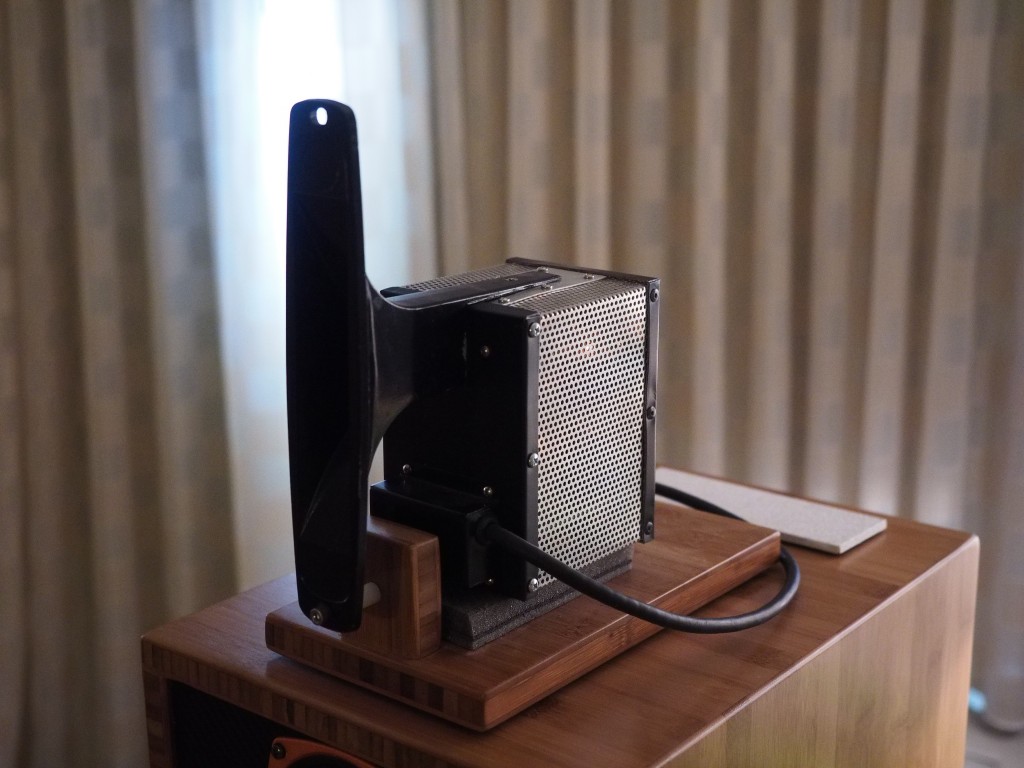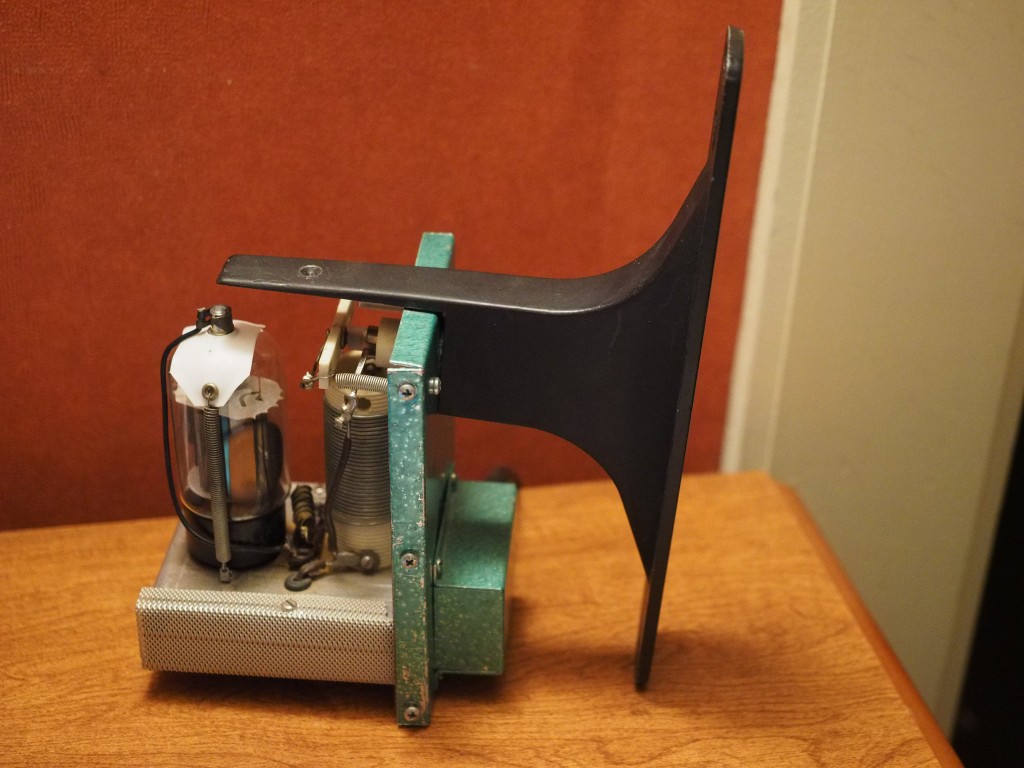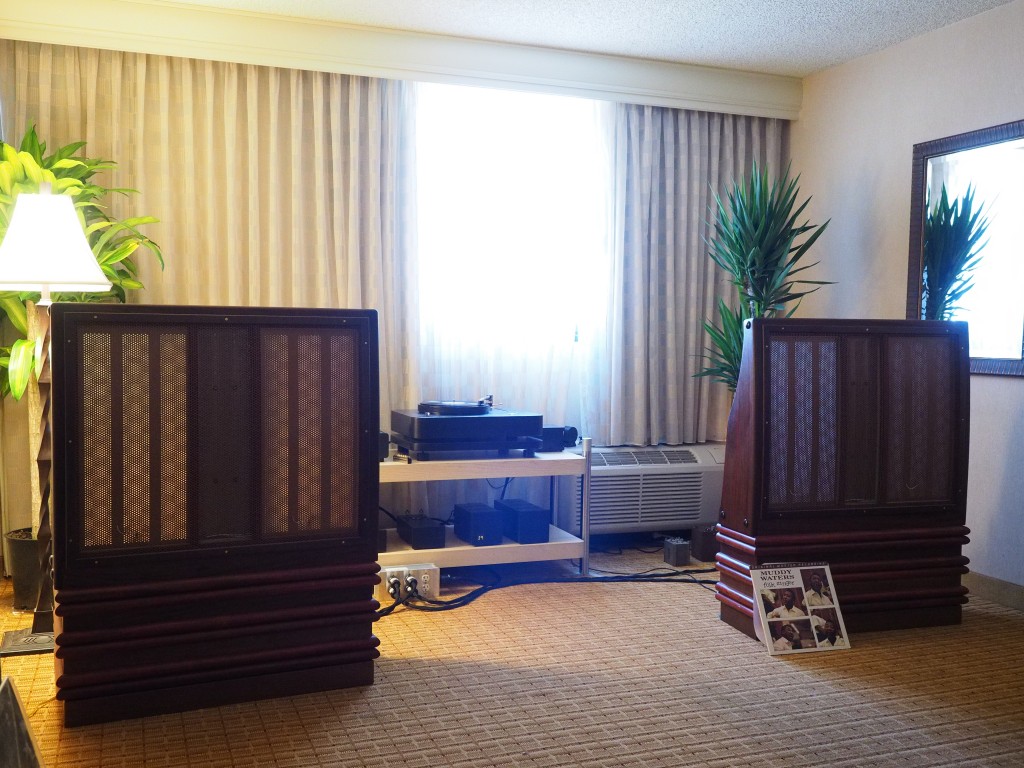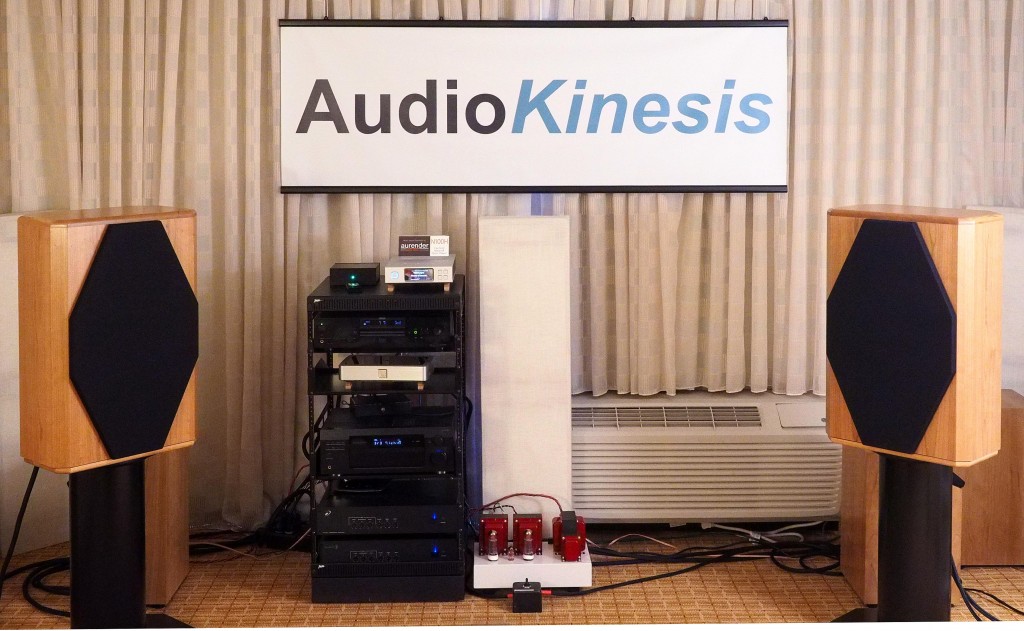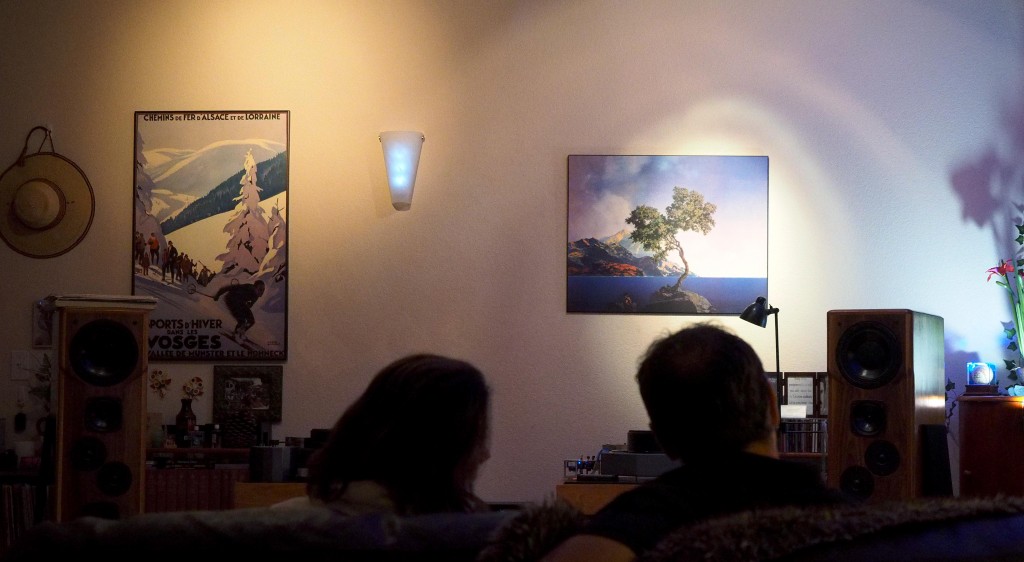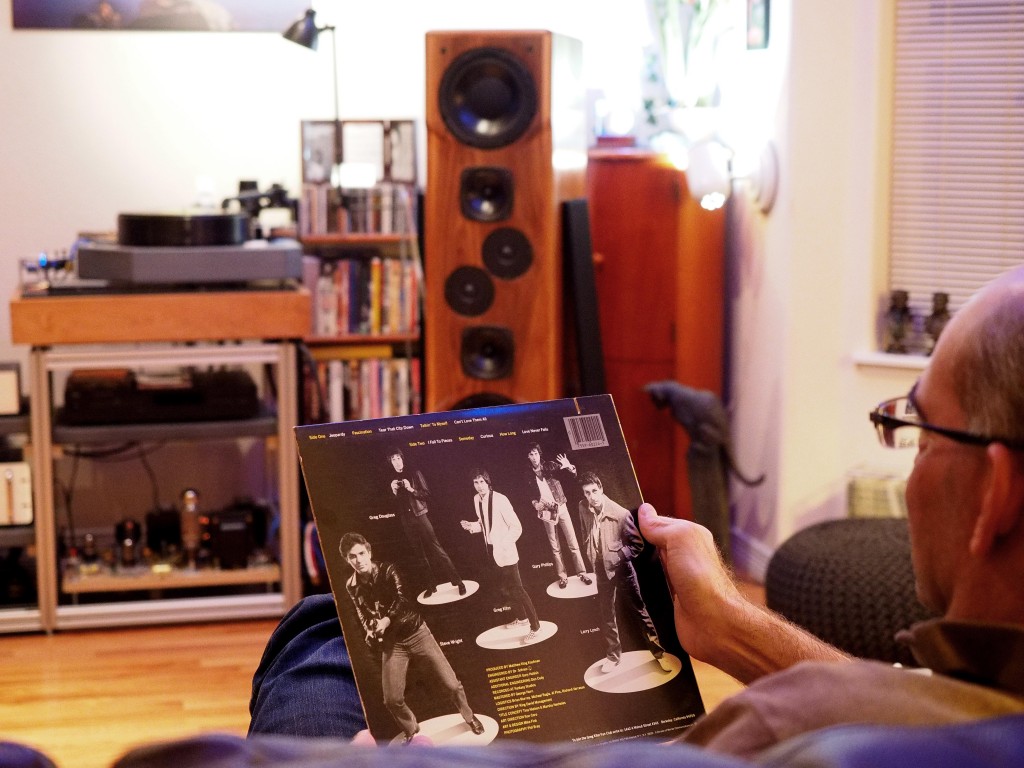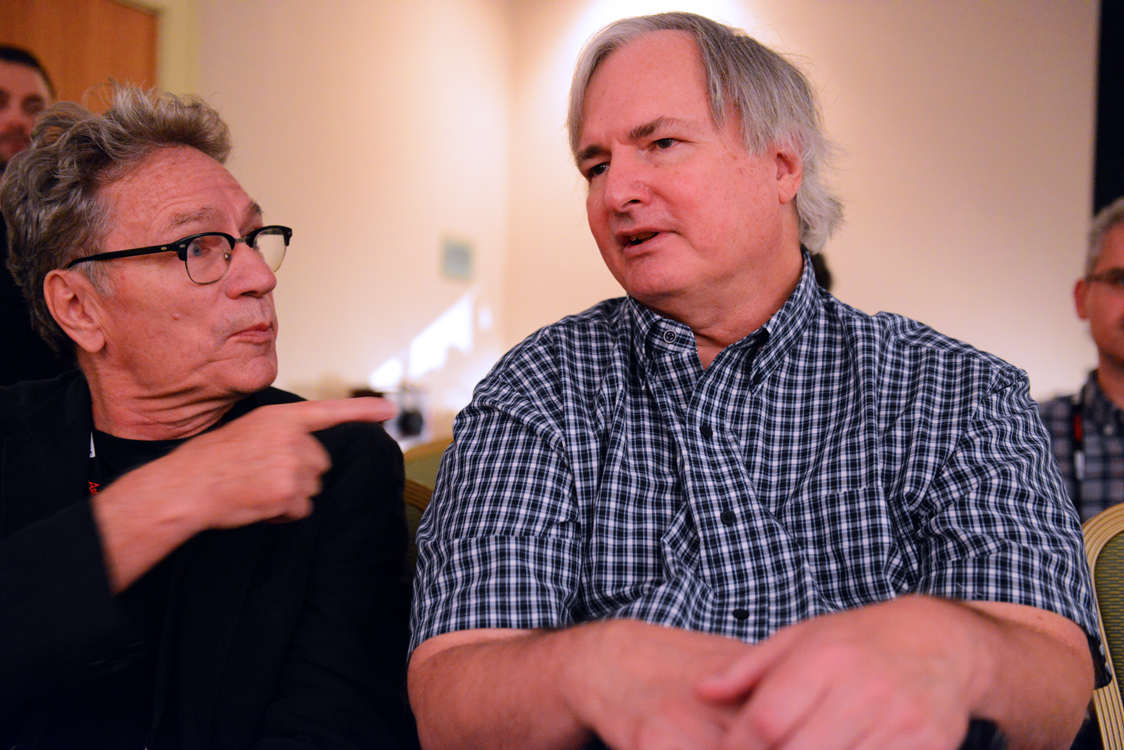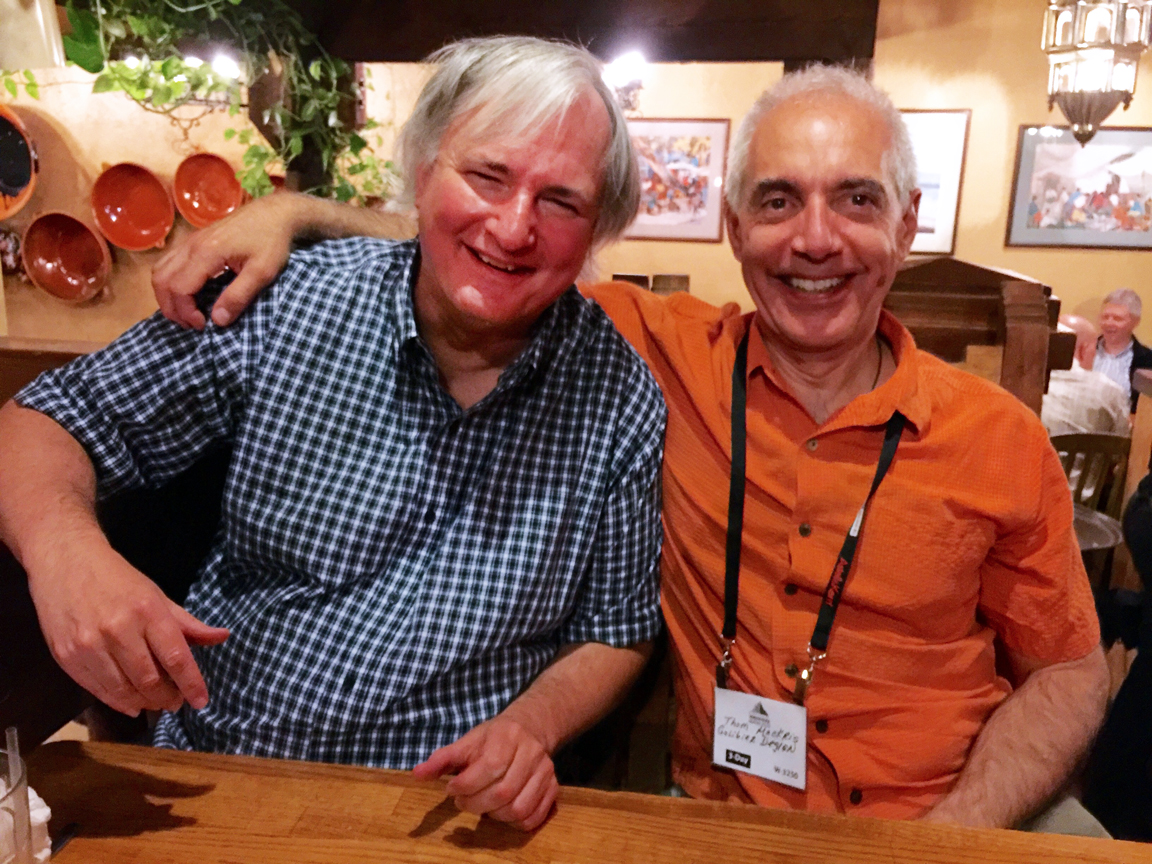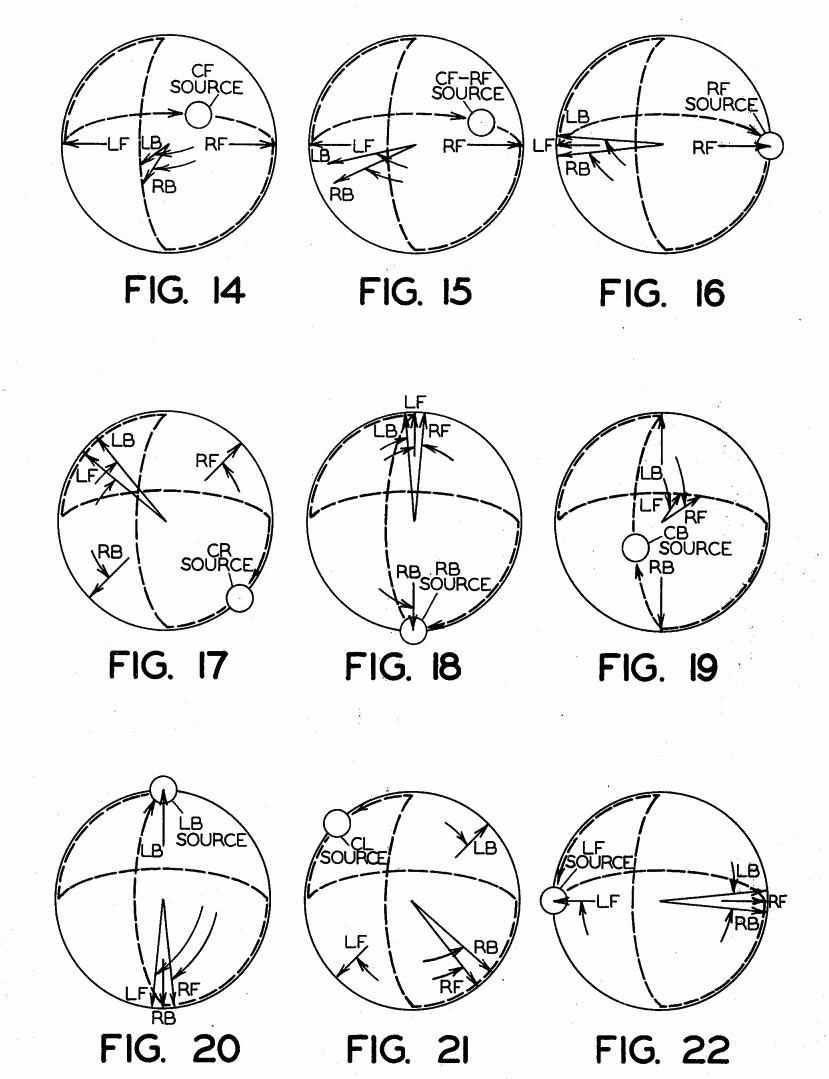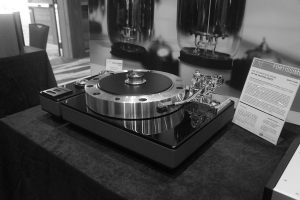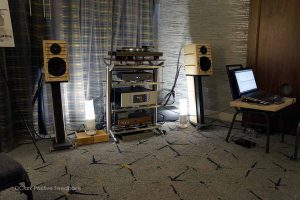Driving north on I-25 after the first day of the show. It's dark, we're tired, and only one lane of three is open. It's just as bad on the other direction. Traffic moves forward at 10 to 15 mph as rain comes down and gigantic paving machines emit asphalt roars and smells. The ten miles of Denver construction ends only to re-start five miles further up the road. Finally, only a few miles from home, the construction ends and nearly all of our fellow motorists have disappeared into the endless north-of-Denver exurbs.
I accelerate the big Acura to freeway speeds and see a glow on the horizon, off to the northeast. What is it? It's orange and lighting miles of the low-hanging rain clouds. Far off in the distance, I see flames … big orange flames. It can only be one thing: a gas well exploded and caught on fire.
The drillers have really good PR teams, but the fire was clearly visible over a wide area on a rainy Friday night. I wonder if it will be on the TV news or our one remaining newspaper, the Denver Post. Oh well, if it isn't, the Post still has good coverage of the Colorado marijuana industry.
Welcome to the 2015 Rocky Mountain Audio Festival! Still weird after 12 years! I don't how the hotel does it, but parking gets worse every single year, with the parking lot of the hotel subdivided into more and more sub-categories. The parking lot opposite the hotel is closed to all visitors, with scores of threatening We Will Tow Your Car signs, and nearly deserted. Just like last year, the year before that, and the year before that. This year, a first: the public road going right to the hotel is being re-paved right as the show opens and 5000 visitors arrive. I wonder how they're going to top that next year? Build an airport? Invite a circus? Oh right, the circus is already here. It's the RMAF!
Thom Mackris (http://galibierdesign.com) and I wandered into the small Vaughn Loudspeakers/Wavelength room almost by accident. I saw the Ionovac tweeters from the hallway and stopped dead in my tracks. I've been in audio since the Sixties and had only seen them in pictures, and now there was a room with a working pair, on demo! I've never forgotten how the Hill Plasmatronics sounded at the 1979 CES (and was quite disappointed by the new-generation German ionic tweeters).
The sound. The only point of comparison was the Plasmatronics, which, like the Vaughn/Ionovac, had unlimited HF dynamics and extension. This is more unusual than it sounds. Usually you get one or the other. If you want extension, look at low-mass diaphragms like the very thin aluminum of freely-suspended ribbons, or the Mylar of electrostats. Both do extension, shimmering beauty, and a wide-open sound really well; they're the usual top-of-the-pile solution for advanced loudspeakers (and this has been true since the Fifties).
If you want power and impact, you have to look elsewhere. Notoriously, compression drivers and horns. Traditionally, these have had rough frequency response, poor impulse response, but stupendous, real-life impact and dynamics, as well as vivid tone colors. Modern diaphragms, phase plugs, and low-diffraction horns have changed this picture while retaining the dynamics and tone colors. But they're still not at the DC-to-light qualities of traditional "exotics" like ribbons or electrostats.
The Hill Plasmatronic was the one exception, and very few people have ever heard (or owned) them. There was the minor issue of recharging the helium tank every few months, and the paper-cone mid and bass drivers, to be honest, were left behind by the UFO performance of the tweeter. Imagine a 1956 Corvette powered by a Tesla powertrain and you get the idea. Interesting but not the full solution.
But I've not forgotten what it sounded like. No limits. No diaphragm sound at all. No compression, no breakup, no coloration, no shrillness, and the ability to start and stop faster than the limits of perception. Bandwidth set by the microphone, not the loudspeaker.
The Plasmatronic was the only time I've heard the realistic sound of metal-on-metal percussion, which is usually dulled, softened, coarsened, or completely broken up by conventional diaphragms. The combination of IM distortion and resonant stored energy results in a type of modulation noise that can be subtle to annoying. With no diaphragm, there's no stored energy. Just ionized gas. As you might imagine, the inertia of a charged gas, compared to aluminum, silk, plastic, or the latest techno-wonder material, is close to zero.
The Ionovac sounds like that. But there are so few! So rare! And what about ozone? Reliability? Parts? And so on?
The most surprising thing, aside from the astonishing sound and out-of-this-world technology, was finding out the pair on demo were new production tweeters, the first since the late Fifties or early Sixties, when the Ionovacs went out of production. This was like finding a Chrysler turbine car, not just in pristine condition, but in perfect working order, and new production with more in the pipeline!
Problems? The notoriously hard-to-find crystals, at the heart of the Ionovac, have been replaced by new-production crystals sourced in the USA. All the rest is new as well. It's basically a small AM transmitter that delivers power into the crystal, and that in turn ionizes and modulates the air in the small inner chamber. The volume of the ionized air changes by a tiny amount, and the horn amplifies it and directs the sound to the listener. Unlike some other ion tweeters, it doesn't fill the room with ozone, and no monthly helium tank is required.
I don't usually approve of diffraction horns (see picture above), because, well, diffraction, and diffraction is a Bad Thing that creates reflections, ripples in the time and frequency domain, etc. etc. But … this is a special case. See, no phase plug. No diaphragm. The usual issue with diffraction at the horn mouth is a back-and-forth reflection between the horn-mouth and the hard surface of the phase plug (and diaphragm). That's where a lot of horn coloration comes from, since the ear is very sensitive to a series of reflections. Not only that, the Ionovac diffaction horn is pretty compact, so the Bad Thing happens once, not many times, and is close in time (a fraction of a millisecond) to the main impulse. Subjectively, there's no horn sound at all, and the diffraction horn works as designed, giving very wide horizontal dispersion (I'd guess 120 degrees or wider, from what I heard in the room).
The rest of the speaker, and the top-of-the-line Wavelength electronics and DAC, had nothing to apologize for. From my perspective as press drudge working the show, it was a mistake going to the Vaughn/Wavelength room first. It took a half-hour of chit-chat in the hallways, with all the rooms booming away at once, to tolerate the sound of ordinary loudspeakers again.
But that's partly me as a loudspeaker designer. I can really hear the sound of materials, and I can tell you ionized air sounds a lot better than anything else. Why the German ion tweeters miss the mark, I have no idea. But they don't sound like the Plasmatronics (unobtanium) or the Ionovac, back on the market after all these years.
Of course, after making my Thrilling Discovery that shakes up the industry, more than one reviewer at the show mentioned that I was a couple of years late. They were there last year, dummy. You just didn't see them.
Better late than never, I guess. But I still think a new-production Ionovac is a big deal, particularly now that the curse of the Compact Disc 20 kHz brickwall limit is finally lifting, thanks to the rebirth of modern LP's and high-res PCM and DSD downloads. Everything old is new again.
Enough fun. Thom and I swam through the turgid sea of solid-state dreck and shoals of "music servers", where the exhibitors put Diana Krall and audiophile blues on endless repeat. We washed ashore at the EMIA room, hosted by Dave Slagle and friends. EMIA stands for Experience Music Intact Audio, a collaboration between Dave Slagle and Jeffrey Jackson.
A lot of the RMAF show-goers were calling EMIA's speakers "refurbished QUAD ESL57's." Hardly. Even the diaphragms were different (and thinner than the originals). As far as I can tell, only the stators are the same, and the drive system is completely different. I overheard the EMIA's called "quasi-direct-drive," which seems appropriate. You see, electrostats typically use step-up transformers with very high step-up ratios to swing the voltage on the stators back and forth (the diaphragm is kept at a constant DC potential in the 5 kV range). If you're using vacuum-tube amps to drive electrostats, the signal is stepped down through the output transformer, up through the built-in ESL transformer, then goes through a maze of high-level crossover components that are part of the ESL transformer. A long and circuitous signal path, and not helped by the low-quality parts used in the UK in the postwar Austerity era.
Dave and Jeffrey swept all that away. There is a single purpose-made output transformer that drives each ESL panel, and the crossover is an integral part of the dedicated push-pull Class A amplifier(s). The QUAD ESL57 is famed as the most transparent (and transient-accurate) speaker ever made. This clears away all the mid-Fifties cruft and lets you hear the ESL as it really is … completely free of "plastic" or "panel" coloration. If you like horn transparency but aren't sure about the residual of horn coloration (and don't need to fill a movie theater), do yourself a favor and hear the new EMIA electrostat. Yes, it's worth a trip to a show, or seeing it at the factory. These are really something. Here are Herb Reichert's comments HERE.
I can only agree with Herb Reichert's impressions. Dave and Jeffrey moved the legendary QUADs into the 21st Century, and without blighting them with the hard and brittle transistor sound of other "direct-drive" ESLs. Electrostats are fiendishly hard to drive since the load is a pure reactance … nearly all of the expensive amplifier watts are reflected right back to the power devices. Transistors really don't like reactive loads; distortion skyrockets and the devices get really, really hot. If the load is reactive enough (a pure capacitance), the little things will short out, rip out the driver stage, and arc-over the electrostatic panels … in a matter of tens of milliseconds. Thus, fast-acting, complex and sound-degrading "protection" circuits, which are not usually mentioned in the product literature.
Tubes, whether pentode or triode, just don't care. The plates get a little hotter, but plates are designed operate at near red-heat anyway. They don't need heat-sinks, and radiate the heat efficiently into the room through convection from the glass envelope and direct infrared emission. In addition, Class A is a natural and stable operating mode for vacuum-tubes, and doesn't require add-on temperature-tracking circuitry (which transistors do). Class A push-pull tubes are perfectly happy with any load you throw at them, and if the amp has zero to low feedback, there's no effect on stability, either. If all the power is reflected right back to the plates, so what? There's no effect on operation or the sound.
Although tubes are the natural counterpart for electrostats, the rigamarole of cascaded step-down transformers and step-up transformers (with the additional muck of speaker wires and crossover components) has always limited the sonic potential of the combination. Moving the crossover debris to the front of the amplifier (and making it part of the circuit) and using a purpose-designed high-voltage transformer solves many problems all at once.
As you can see, the "ESL57" part of the EMIA is the smallest and least important part of what they've done. Their topology can be applied to any electrostat of any era, with equal benefits. The ESL57 is an obvious starting point because of its superb performance in standard (restored) form, but the EMIA approach lets you hear what's been hidden all along. In the same way the Ionovac is a great re-discovery of an old technology, the EMIA is a great approach to electrostats, and a very welcome alternative to transistor-powered panels. Thank you, Dave and Jeffrey!
Well, Thom and I are two hours into the show. Now what? Most of the show is rooms blaring with transistor grit, little speakers that are shrill and harsh, and the blight of music servers with canned playlists. Blech. The contrast between the Vaughn/Wavelength and EMIA rooms and everything else is not easy to take, and certainly altered our perception of the show. We need to decompress. Where can we relax and find something that sounds good?
Nothing like visiting old favorites. So we did some more swimming through the shoals of the not-great and the really-bad, and finally arrived at the top floor. Ah! Sweet music to our ears! How nice! And what a contrast to the roar and blare of the rest of the show. We were at the Audio Kinesis room, of course, hosted by the ever-affable Duke LeJeune, one of the nicest (and most knowledgeable) guys in audio. His subtle use of additional room-reflecting drivers has evolved since last year, looks better, has much more flexible placement options, and last but certainly not least, sounds better. Going out on a small limb here, but Duke's speakers combine the natural and relaxed sound of high-efficiency with the spacious ambience of dipoles and electrostats. They thrive on good vacuum-tube amplifiers of moderate to medium power, and to my surprise, sounded damn good on a visiting Class D amplifier (which I didn't expect at all).
I'm a fan of high-efficiency speakers partly because they sound so natural at low levels, which is something most audiophiles wouldn't expect. One of the downsides of complex audiophile speakers of low efficiency is they only sound good at medium to high levels, and seem to "come apart" and sound disjointed at low to moderate levels (this doesn't apply to electrostats, which work on different principles). If you increase the "real" Theile/Small efficiency to 92 to 98 dB/meter/watt (1% to 4% conversion efficiency), not only can you start using nicer-sounding amplifiers, but the speakers get a lot better at background music and rendering quiet little details. In other words, you don't need to turn up the sound in order to hear anything … it's all there at all levels, which makes casual listening a lot more enjoyable.
The lack of resolution at low levels is the reason that audiophiles, along with show exhibitors, blast you with sound. Sure, it has more impact and leaves more of an impression on the visitor, but there are a lot of very expensive audiophile systems (in the $50,000 to $200,000 range) that are unsuitable for background music. The sound gets are dark and murky, and if the speaker is complex, starts to sound disjointed and incoherent. Turn the volume up, and it comes into focus, until the speaker and amp start to break up (and this year there was a lot of that at the show).
The great hidden charm of high efficiency is leaving the volume selection up to you, not the system. There's still music there when it plays quietly, and if you want full-volume peaks from an orchestra in a Vienna symphony hall or a stage full of guitarists dodging Lone Star beer bottles, HE speakers will do that too. That's what I like about HE speakers … they play it all, the rough with the smooth. It's about getting a kick out of lots of different kinds of music. Your music collection is expanded instead of narrowed to a few audiophile favorites.
But … a lot of HE systems beam the sound at you, thanks to the horns. There's an annoying fad in favor of narrow directivity in the speaker-design community right now, and there are many speakers, particularly the HE fraternity, that beam sound in a 90-degree cone (or narrower). As a group, I don't like 'em, although I guess they are OK for home theater. But not for music. They sound dry and dusty to me, and can verge on PA-system levels of aggressiveness. No thank you.
By contrast, the spacious big-sky sound of the Audio Kinesis is not designed to shock-and-awe, but quietly sneak up on the listener and give them a big smile. The longer you stay, the better it sounds. I suspect the long-term satisfaction is good, because this is the room I keep coming back to, year after year, and it always sounds more like music than the prevailing fads of the high-end world. Duke has good taste, and that counts for a lot in my book.
Moving down the main floor of the hotel, physical digital media are on the way out. I saw no high-res DVD-A's, Blueray discs, or SACD's at all. The "audiophile" CD's were the usual gold-disc stuff we saw back in the early Nineties. But man, were there LP's everywhere. If a room had good sound, the chances were better than 50/50 that there was a record spinning on a turntable, or reels turning on a tape deck. It's the music servers playing the 30-year-old Compact Disc 44/1/16 PCM format that were defining the lower bound of sound quality. Sure, I knew high-rez PCM and DSD downloads are the Next Big Thing, but you know what I saw and heard? LP's. Records everywhere. It was one way to get around the security cordon of music servers, since exhibitors are understandably nervous about strange USB sticks that might be infected with who-knows-what viruses. I saw more than one room derailed by a crashed music server.
I'm pretty sure that LP's will have the last laugh and outlast Compact Discs. Sales of LP's worldwide have reached 10% of all CD sales, pressing plants worldwide are running at capacity, LP sales continue to increase 40% year-by-year, and CD sales continue to decline, year-by-year. You may have noticed the price of used CD's are dropping to zero, unless they are very rare and out-of-print. Downloads and streaming are replacing physical media … with the exception of LP's.
Spotify, Pandora and other streaming services are dominating the casual and mobile music market. To be perfectly honest, although I despise lossy compression in principle, 256 kbps AAC compression is reasonably close to Red Book 44.1/16 PCM, and certainly plenty good enough for automotive and portable use in noisy environments. The LP is growing in the sit-down-and-listen market, or alternatively, the let's-get-up-and-dance market. Not a bad place to be.
LP's are the opposite of streaming, and the sonic equivalent of the Slow Food movement. Admiring and reading the beautiful LP jacket, handling the disc, and cueing the stylus is a lot more satisfying than random surfing on Spotify or cracking open a chintzy little plastic box of the CD. And the sound. The LP just sounds better, more like music, even it was sourced from PCM masters (although those were most likely a professional 96/24 PCM format, not the consumer-grade 44.1/16 format). Surprisingly, even Apple requires that "Mastered for iTunes" be sourced from professional 88.2/24 or 96/24 PCM originals, and also be free of intersample clipping (which would disqualify a lot of pop CD's on the market).
Which brings me to the best surprise of the show: the Orbit turntable, a Kickstarter project by U-Turn Audio that has a real turntable for $179, or the super-duper version for $309. This includes tonearm and an Audio-Technica or Grado cartridge, and the Pluto phono preamp is another $89.
This was no Kickstarter fantasy project. They asked for $67,500, and were quickly deluged with $125,000. The Kickstarter page now shows a subscription of $234,000. By the way, it was up and playing in the "System for less than $1,000" room, and honestly, it was one of the better-sounding sources at the show. No joke, guys, I heard a lot worse, most of all, those miserable music servers that were in nearly every room.
Records sounded like records, instead of CD's, and the Orbit looked great in motion. Be honest, what would you rather see: a featureless aluminum box with a Nineties-style LCD reading the track time, or a disc gently spinning with a colorful label going round and round? Yeah, I know, you all want a tape deck with 10.5" reels. Uh huh, and a secret stash of second-generation copies of Beatles mastertapes, right?
But all those records! There are so many! You know how awful the CD transfers are. And there is a whole universe of music that will never, ever be on Spotify, Compact Discs, or even more unlikely, a high-res PCM or DSD download. Sure, it's fun to show off your latest download to your audiophile pals, and go gosh-wow over the sound (so clear! listen to that triangle!), but what do you enjoy listening to most? I would guess music, and a lot of it. Which is where LP's come in. Why not take a vacation from the endless pursuit of this week's version of high-res digital and just listen for fun?
Best Sound of the Show? Well, it wasn't at the hotel. It was 25 miles north, after the intense Fellini-movie drive at the beginning of the article. On Friday and Saturday evening, Thom Mackris of Galibier Design opened his home to me, John Atwood, and several guests from Dallas, the Bay Area, and Seattle. He was demoing a prototype of his new turntable and a pair of prototype single-ended triode (300B) amplifiers, which will probably be called the NiWatts (there's a nearby town named after Chief Niwot).
I'm not an expert on turntables, but three of the out-of-town guests came right out and said the new turntable was the best they'd ever heard … at any price. I haven't heard the crazy $80,000 "reference" turntables they were talking about, but I'll say the EMT and (modified) Garrard 301's have met their match. My desire to one day own a fully restored EMT has been extinguished. This thing is better, and it's made right here in the USA.
One of Thom's guests nearly walked out with the prototype; Thom and his guest split the difference, and settled on the first production model off the line. Coming fresh from the show, Thom's system made quite a sensation. There was never any audible distortion or harshness; the tonal balance just-right; incredibly vivid-sounding, and never sounded "hi-fi" at all, no matter what record we played. It effortlessly did things that I didn't hear anywhere at the show.
My quick impression of Thom's prototype turntable is that it combines the propulsion and drive of the EMT and modified Garrard 301's with the air, spaciousness, and clear bass line of a modern high-tech-platter turntable. And I've yet to hear digital really do justice to the sense of rhythm that a classic 50's or 60's LP has. Maybe it's an artifact of LP playback, but I dunno … digital usually sounds a little flatter than the real thing. It was especially thrilling what the whole system did with $2 thrift-store finds. Clicks and pops, sure, along with a share of record wear, but it played more music than all of the RMAF put together, and kept doing so, record after record, all evening long. And it did the same thing the second evening, just as good, without breaking a sweat.
Here's one of those thrift-store finds. Man, did it sound good! Wow! You just forgot about all that boring audiophile crap and just wanted to play more records, with the listeners saying "play this! play this!"
Some of the credit has to go to the NiWatt amplifiers. These are the best single-ended amplifiers I've heard to date. Again, with a remarkable sense of drive and propulsion, an area where SET's can fall down rather badly.
After listening to the NiWatts, I started to understand why magazine reviewers obsess about "slam" … when a system can't deliver a sense of the bass line, you turn it up until you start to hear and feel it. That's why so many of the systems at the show were played at oppressive levels, so you could finally get a sense of the rhythm of the music. But … if power amps are done correctly, you can feel and get a sense of the bass line at any level. Not many amps do this; there are usually power-supply faults that interfere with the story told through the bass line of the music, so the listener keeps cranking up the volume to boom-car levels.
Thom's prototype turntable and power amps combine to make the whole audiophile chase-the-monkey unnecessary. It's just one record after another. You'll want to check out what the production models sound like … maybe six months?
It's true I mostly go to shows like the RMAF to meet old friends and schmooze with folks in the industry. But it's really fun to make exciting discoveries like the born-again Ionovac, the EMIA electrostatic speaker, the increasing sophistication of AudioKinesis, the fantastic value and sound quality of the U-Turn kickstarter turntable, and what Thom Mackris accomplished in the last year. Maybe there was more Heaven at the Rocky Mountain show than I realized.
(Photo credits, Lynn Olson, Olympus OM-D EM-1, f/2.8 12-40 zoom, no flash, at ISO 3200.)
Lynn Olson
Sidebar for all of you out there…
Quick note for the reader: as you can tell, I'm not "objective" in a magazine-reviewer sense. Thom's a neighbor of mine, I've gone over and listened over the last several years, thrown in my own two cents, and so on. I can't be objective or neutral. All audio designers know the kind of sound they want to get, and all of them have a point-of-view of the "right" way to design audio gear.
If I think something is awesome and amazingly good, that just means it aligns with the way I like to do things. Reviewers experience consumer products as an all-in-one experience, not the subtle fine-tuning of product development. They sometimes get to hear preview prototypes, but not all the finely graded a little-bit-better and a little-bit-worse that happens during development. A designer steadily but surely moves towards a subjective goal (although I've heard unsettling rumors there are well-known professional speaker designers that never listen to what they design). In short, there's stuff I like and don't like, and David Robinson indulges my style of writing without making it fit into a corporate style guide.
Lynn Olson




